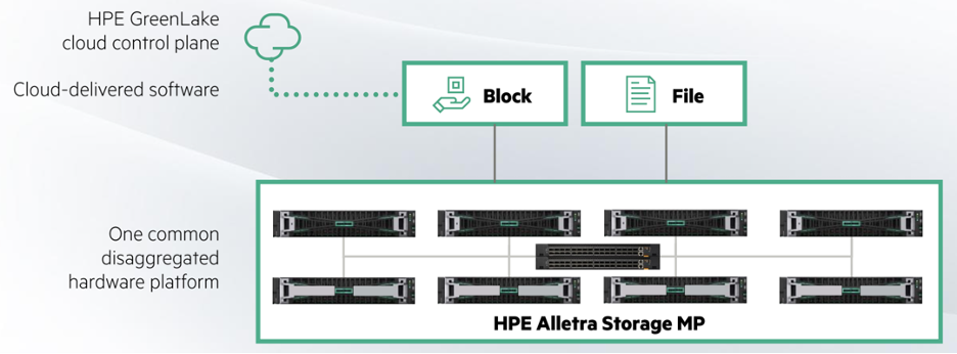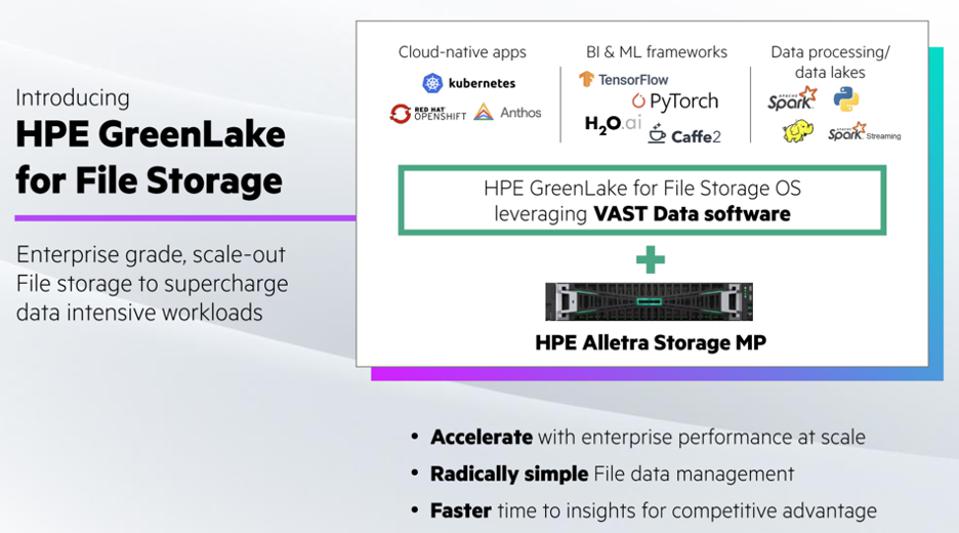HPE GreenLake Storage Makes VAST Improvements
HPE recently brought 40 or so industry analysts—myself included—to its Spring, Texas headquarters for its 2023 GreenLake Day for storage. As a longtime compute analyst who’s recently taken on covering storage as well, I was especially interested in learning more about how compute and storage converge in the data-centric organization. The day focused on three areas: simplifying storage in the enterprise, delivering best-in-class performance and driving down costs. In the following sections, I'll cover HPE's announcements across these areas and what they mean to enterprise IT.
HPE Alletra Storage MP — Disaggregation Drives Simplicity, Performance
Here’s the challenge many IT organizations face: siloed storage deployments built to support different environments (block, file) have led to more complexity when it comes to managing those environments, as well as continued increases in costs—both direct and as a result of the complexities just mentioned.
To address this challenge, HPE offers Alletra MP, a disaggregated, modular architecture designed for scale-out for both block and file storage.

The above diagram shows the disaggregated nature of Alletra MP and how HPE can use it as a universal platform for block and file. Alletra Storage MP controller nodes connect to Alletra Storage capacity nodes over an NVMe fabric. This configuration enables an organization to use that single platform on the back end for block and file needs from the GreenLake cloud control plane.
This disaggregation is a big deal for IT professionals who struggle with managing multiple storage environments—and the costs associated with deploying them. Having one platform that can be deployed on a small scale and then grow with the needs of an organization is a significant plus. Beyond that, the single interface makes managing this environment much easier for storage administrators and other IT pros who are already overburdened.
I like what HPE is doing with Alletra Storage MP. The consolidation of the platform simplifies deployment and management for storage environments. It also breaks down the silos that create a drag on business productivity and efficiency. And finally, it should result in reduced costs. HPE estimates a 66% reduction in price-performance for block storage. Even if the actual number is a little shy of that estimate, real operational efficiencies will make Alletra Storage MP a big win for customers.
HPE and VAST deliver performance for the masses
If Alletra Storage MP is the foundational element of HPE’s recent storage announcements, the company’s partnership with VAST Data might have been its most significant element. This partnership marries the hardware design capabilities of HPE with the know-how of an industry leader in the all-flash file storage market.

VAST's highly performant scale-out architecture blends nicely with Alletra Storage MP to deliver a storage system tailored for the enterprise that must "do faster," more simply and more reliably. This partnership fills a significant gap for HPE, which lacked a file storage solution. Not only does this partnership fill that gap, but it also catapults HPE storage into a leadership position. As I consider VAST Data’s track record, it’s clear that the company's Universal Storage solution clearly resonates with leading-edge organizations that span industries from government to life sciences to financial services. The common requirements from these customers center on performance, reliability and data integrity at scale. This tells me that VAST delivers real-world value to customer organizations willing to pay a premium for the best. For all these reasons, I think that HPE scored a big win with this partnership.
I'd also score partnership as a huge success for VAST. VAST's average deal size is $1.2 million. That's a lot of software and a lot of storage. The average VAST customer manages about 12 petabytes of data. Do you see the picture unfolding? The company services really big customers with really big budgets, which is a good thing. What would be even better is the ability to service these large customers while simultaneously enabling down-market customers to enjoy the same performance, reliability and data integrity. And this is precisely what the HPE GreenLake partnership provides. This partnership truly delivers on the cliché of democratization, and this is a huge TAM expander for VAST Data.
What does all this mean for enterprise IT?
As I stated in my introduction, I went into this analyst day to better understand how these announcements impacted organizations in a more general sense. It's easy to get excited about specific technologies, but how do those technologies affect the bottom line for the data-centric organization?
First, every organization that will be around in 10 years is data-centric. Being driven by data is more than just a competitive advantage for the established enterprise. It's a survival technique against the digital upstarts that are disrupting virtually every industry.
While this may sound obvious, it's essential to understand that the transformation businesses require to become data-centric can only happen with a corresponding transformation in IT. This transformation is cultural and operational and technical. Storage, network and server administrators have to shift their focus and perform all of their technical functions while also acting as consultants to business users. And this only happens when a cloud operating model is used. The cloud, after all, is the great enabler, partner and competitor to enterprise IT.
From a user perspective, the lines between compute, storage and networking are now blurred to the point of being nonexistent. At this point, they are all just resources. In this context, IT professionals standing up new development environments or workloads want point-and-click simplicity for provisioning. As an old IT guy, this pains me to say—but it’s true. And HPE GreenLake delivers this cloud operating model to the enterprise. The VAST partnership helps HPE get a lot closer to delivering the cloud to its customers.
What about object storage?
The lack of an object store solution as part of this announcement between HPE and VAST Data is somewhat surprising. Alletra Storage MP is more than capable of supporting it, and VAST has an object storage solution of its own. Yet it's not available on GreenLake Storage.

I suspect this is a case of crawl/walk/run. This addition of file storage through VAST Data is highly significant. If I’m the one managing the portfolio for HPE, I want to ensure that this service rolls out smoothly and effectively. Then I can turn my attention to rounding out my portfolio with an object storage solution. After all, HPE has declared that this is its year of storage.
I'll check in over the next few quarters as HPE continues its focus on the GreenLake Storage portfolio and services. I'm sure there will be a lot more news to discuss.























































































